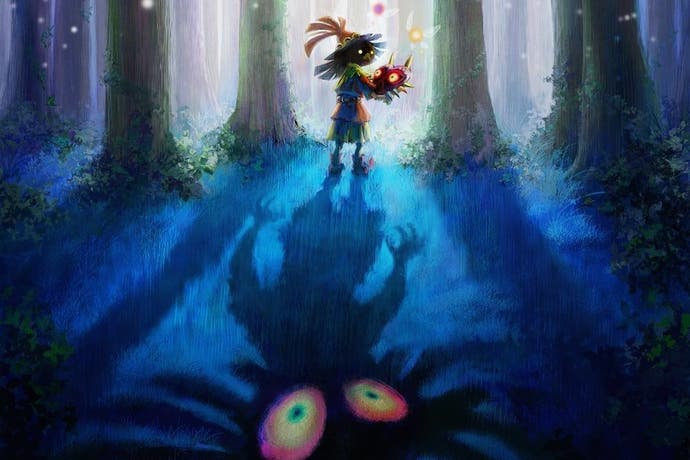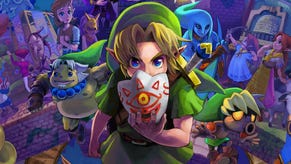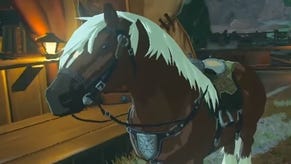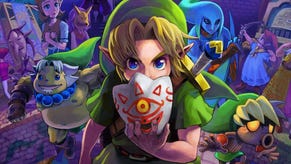The Legend of Zelda: Majora's Mask 3D review
Bad moon falling.
Eurogamer has dropped review scores and replaced them with a new recommendation system. Read the editor's blog to find out more.
When Nintendo decided to tackle time-travel in its 1998 masterpiece, The Legend of Zelda: Ocarina of Time, the approach it took was mythic, built on moral fulfilment. The boy will venture through time to become a man, it foretold. He will travel to the future to undo the wrongs of the past, and travel to the past to prevent the wrongs of the future. He will face evil and thwart it. He will master his destiny and the world around him.
Two years later there was a sequel, Majora's Mask - now available in this splendid remake for 3DS - and it returned to the time-travel theme. It was set just after Ocarina of Time, with the same Link returned to childhood and continuing his adventures in a strange new land. It was built on the same engine and used much of the same artwork and designs. And yet, at heart, it could not have been a more different game.
It asked: what's it like to be a child in an adult world that's falling apart? Never mind facing evil, how do you face sadness and regret? And how do you deal with the inevitability of failure? You pick yourself up, go back to the beginning and start again - clawing a little victory for yourself each time, banking a little experience for later. Majora's Mask isn't the stuff of myth, it's the school of hard knocks and broken dreams, dressed up like an eerie fairy tale.

The moon is falling on the land of Termina - its looming, grimacing face as sinister as only the most childish horrors can be. This isn't happening because of some evil scheme, but because a lost and lonely bundle of rags called the Skull Kid played with something he shouldn't - the cursed mask of the title - and succumbed to its destructive urges. In three days' time, the moon will fall and burn the world, killing everyone. You can't stop it. Not the first time, and probably not the next dozen times either.
This is the bitter twist of time-travel in Majora's Mask. Time passes here - at the rate of an hour a minute, it fair gushes down the drain - and Link's magical ocarina no longer carries him back and forth at will until the timeline is arranged to your satisfaction. It can slow time, skip you forward through it, or it can return you to the start of the first day, with everything back as it was: all your work undone, and only the most precious of your possessions with you.
It's an ambitious system, unloved by many players, and it's easy to see why. It is opaque and burdensome and stressful. The rules of what changes and what doesn't each time you hit rewind aren't consistent or clearly explained. Even when you have it figured out, miscalculating how much time you have left or triggering a more complex series of events than you expected can often leave you having to scrap and repeat sections of the game. It doesn't feel empowering - quite the opposite. You don't control the flow of time so much as feel helplessly as its mercy: you set reminders, miss appointments, sweat nervously as you race the clock, never allowed to forget for a minute that time is running out and you can't be everywhere at once. It can be hard not to respond by playing with ruthless, pared down, planned-out efficiency - not really in the spirit of Zelda games, which reward aimless curiosity with their many detours, mysteries and secrets.

Many players would have wished this time system away, but it's still present in this new version. Of course it is. Love it or hate it, Majora's Mask would be unimaginable without it. It's the heart of the game and the root of many things that make it special.
I'm not referring to the game's quartet of dungeons. The flow of time adds nothing but unearned worry to these typically devious and abstract puzzle palaces (the Stone Tower toward the end of the game is a head-spinning stand-out). They certainly don't need a ticking time bomb to make them more challenging. At other points during the preamble to each dungeon it can seem like the designers, working under director Eiji Aonuma, now the series' overseer, have forgotten all about the game's chief gimmick.
That all changes in Clock Town. In Termina's hub, the businesses and people run to an intricate schedule which you can learn through repetition to manipulate, like Bill Murray in Groundhog Day. You can play grifter or gumshoe: learn the lottery-winning numbers every day, follow the comings and goings of the postman, solve the mystery of the town thief. Or you can look deeper, for more personal secrets.
Late at night, a man who says he's dead dances to a familiar theme outside the town gates. On the third day, the little girl at the ranch won't talk - what happened to her? On the second day, it always rains, and the innkeeper goes to the laundry pool to nurse her broken heart. Can you mend it? Yes - this Cupid's errand turns out to be the game's most complex and poignant subplot. But it will come at a sad cost, and perhaps not on the same day you finally save the world. There isn't time. You'll have to hit rewind and break her heart all over again. In Majora's Mask, many happy endings are possible, but you can't have all of them at once.
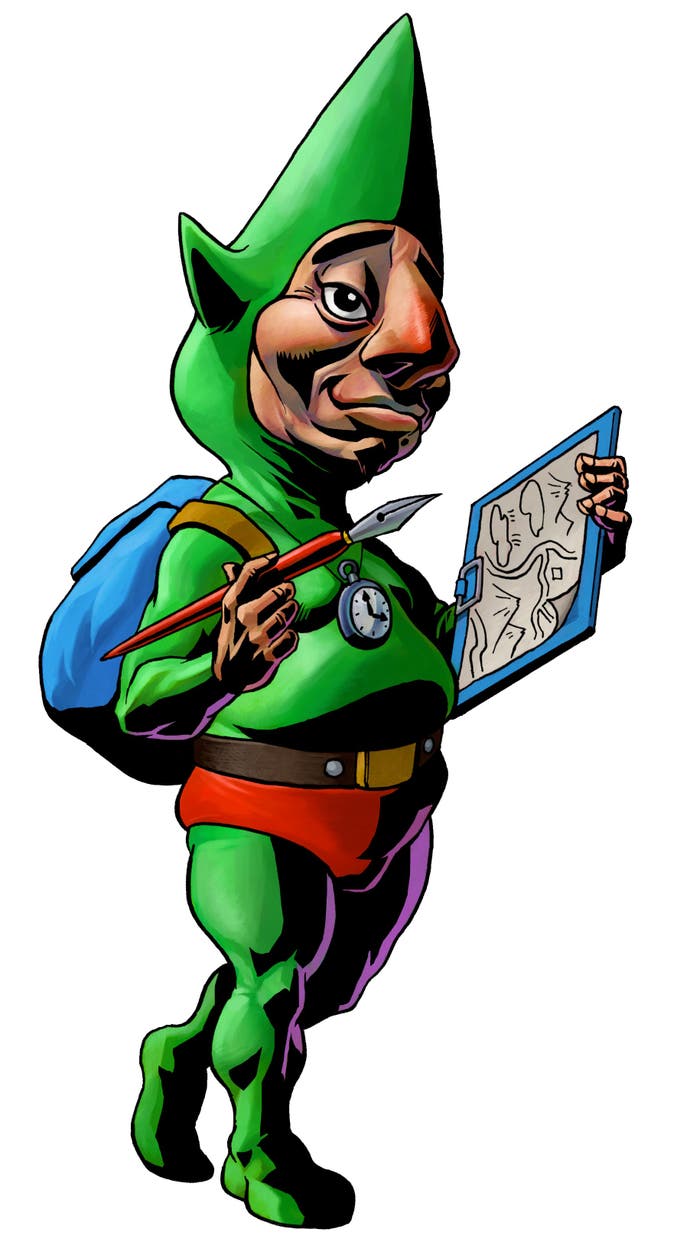
The game's mechanics - or perhaps we should use the watchmaker's term and call it a movement - are cumbersome and haven't aged all that well, but it was experimental stuff for its time (all of 15 years ago) and it remains a daring direction for a major family video game series to take. It's touching to observe this clockwork society going through the motions at the end of the world, and it draws on a seam of bittersweet melancholy that runs through the game's wonderfully economical script. If that all sounds a bit heavy, there are plenty of other seams to follow: mischievous humour, surreal nonsense, outright creepiness and even Saturday morning hi-jinks like the cow-stealing ghosts and the fish-man rock band. Some of the broader bits falls flat, but it's still a rich mine of material.
You have to embrace Majora's Mask's awkwardness to get the best out of it. Taken as a straight run through its main storyline - as straight as you can make it, anyway - it is a mediocre Zelda game at best. It starts in a slow and clumsy manner; its world feels constrained, its horizons small, its systems cluttered and full of busywork. You're constantly fast-travelling, swapping items around, tapping out ocarina melodies and fiddling instead of drinking it in.
The endgame, though, is perhaps the richest in the series. The real goal of the game isn't to stop the moon falling from the sky. It's not even to collect every heart piece and upgrade. It's to collect every mask.
In any other sequel, the masks would have been the most notable gimmick. Three of them allow you, in classic platform-game style, to take on a different form with different abilities: the brawling Goron who can roll into a ball and zoom along, the Deku shrub who glides around as a sort of petal-copter, and the sleek-swimming Zora. There are many more. Some of them are important to the quest or side quests, some confer bonuses like run speed, some allow you to summon a quizzical fox or humour a boring grandmother. They're delightful and strange, and completing the set requires deep investment in the side quests that are tracked helpfully (with a schedule) in your Bomber's Notebook. That, in turn, means getting to grips with that relentless, unforgiving clock.
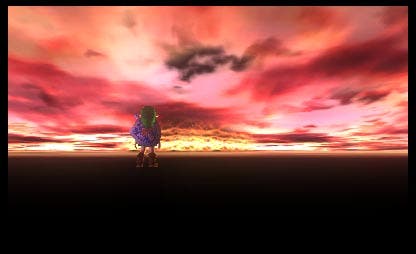
There are a couple of minor changes in this new edition of the game to make this easier; you can advance the clock to specific times, rather than just jump forward to dawn or dusk and wait around. But you might be surprised to learn that the tweaks are far more extensive elsewhere, including some fairly important (and beneficial) changes to save structure, boss battles, swimming controls, the addition of fishing mini-games and more. Visually, the game has been completely transformed - I'd say beyond recognition, but the innumerable updated models and locations look so right that it's the muddy and basic originals that will look wrong when you see them in old screenshots.
Across the recent remakes of Ocarina of Time and The Wind Waker, and now Majora's Mask 3D, Eiji Aonuma - working in this case with Tokyo's Grezzo studio - has been emboldened to take an ever more revisionist approaches to Zelda's past, beautifying and overhauling and adding and adjusting more with each edition. In theory, it's a purist's nightmare, with shades of George Lucas ruining Star Wars. But there's no denying that these are superlative versions of classic games, incontrovertibly improved and truer to themselves than they were to start with.
Majora's Mask 3D demonstrates that the art of a good remake is in knowing which flaws to leave in. It's much better, even if it's not as good as you remember it. It's slick and gorgeous but it has been allowed to age. It's still the most ornery, problematic, weird and haunting Zelda game - and perhaps the most fascinating one.
